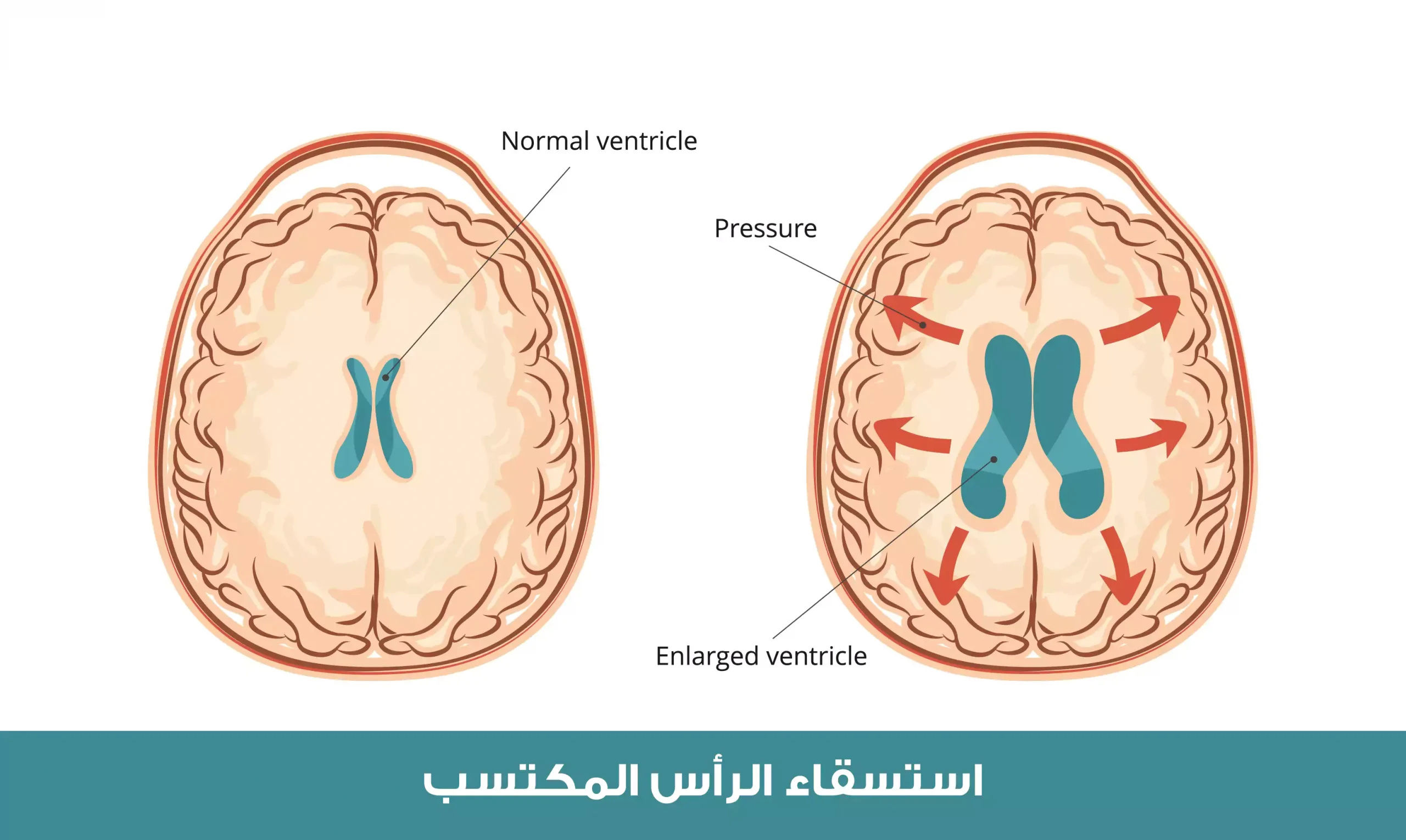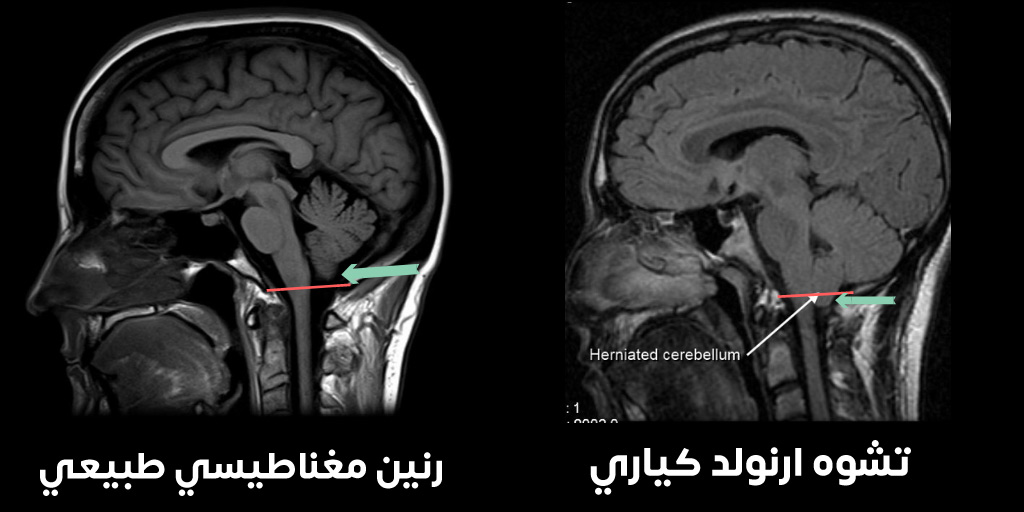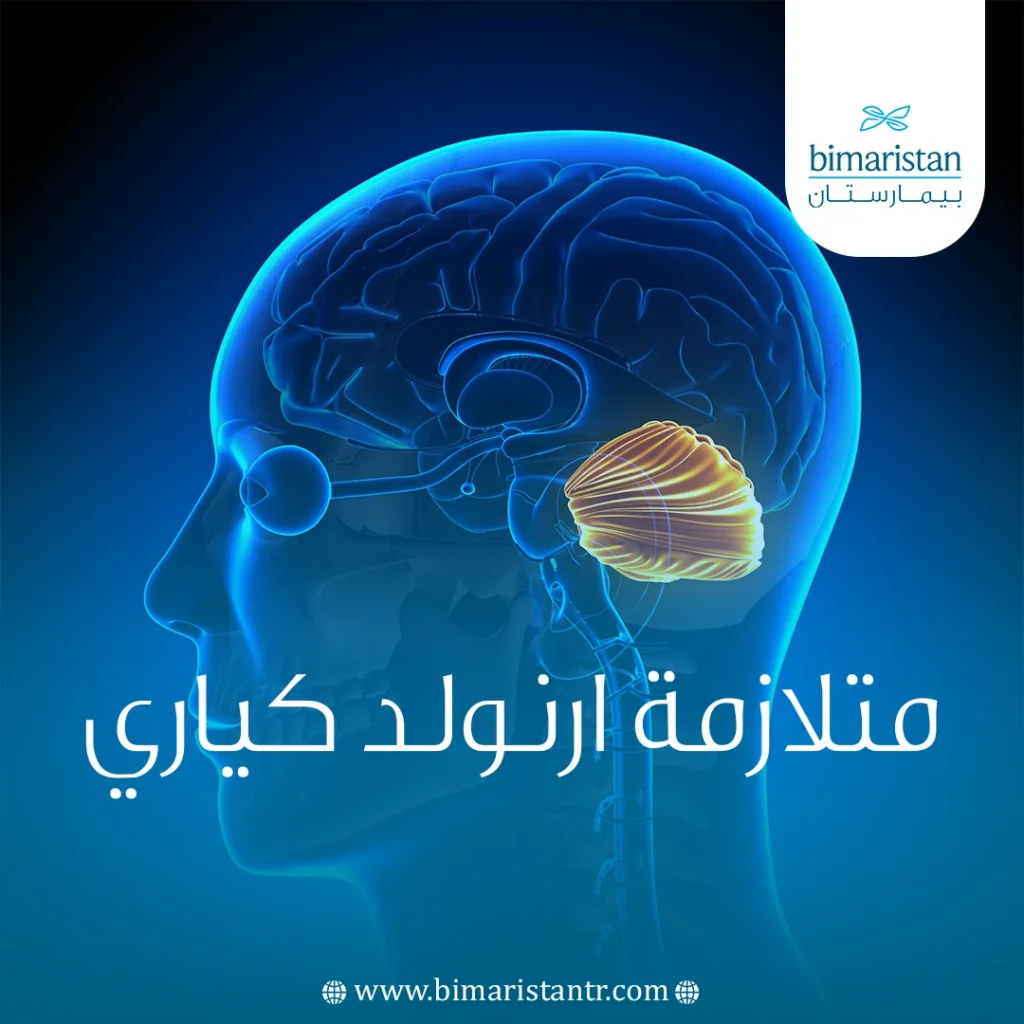تعد متلازمة ارنولد كياري من التشوهات العصبية المُشاهدة عند الأطفال وقد تترافق مع طيف واسع من الأعراض، يمكن تشخيص وعلاج هذا التشوه على يد أمهر الأطباء في تركيا.
ما هي متلازمة ارنولد كياري؟
أول من وصف متلازمة ارنولد كياري هو الطبيب هانس كياري عام 1890 وجاء فيما بعد الطبيب جوليس ارنولد ووصف المتلازمة بشكل أكثر وضوحاً لتسما فيما بعد بتشوه أرنولد كياري.
يُعتقد أن التشوه يحصل أثناء الحياة الجنينية بسبب طفرات جينية أو افتقار الأم للعناصر الغذائية أثناء الحمل.
تحدث المتلازمة عند هبوط جزء من أسفل الدماغ (المخيخ) باتجاه القناة الفقرية عبر الثقبة الكبيرة بسبب صغر الفراغ العظمي في قاعدة الجمجمة الأمر الذي يؤدي لارتفاع ضغط المخيخ فيهبط للأسفل.
يسبب هذا الهبوط منع تصريف السائل الدماغي الشوكي مسبباً استسقاء الرأس hydrocephalus.

أنماط متلازمة ارنولد كياري
يصنف تشوه كياري إلى أربع أنماط وفقاً لدرجة الهبوط والأعراض ووجود تشوهات عصبية مرافقة.
النمط الأول من تشوه كياري
يكون حجم الجمجمة صغيراً مما يؤدي إلى ارتفاع الضغط أثناء تطور الجمجمة خلال فترة نمو الطفل ويشاهد هذا النوع في مراحل الطفولة المتأخرة (المراهقة) حيث يزداد الضغط فيهبط المخيخ للأسفل عبر الثقبة الكبيرة باتجاه القناة الفقرية، يمكن أن يحدث هذا النمط لأسباب مكتسبة رافعة للضغط (كالإنتانات والمخدرات) وهذا هو الشكل الأخف والأحسن إنذاراً.
النمط الثاني لتشوه كياري
في هذا النمط يحصل هبوط كمية أكبر من النسيح الدماغي عبر الفتحة الكبيرة foramen magnum باتجاه القناة الفقرية، نشاهد هبوط المخيخ وجزء من جذع الدماغ عند الاطفال الأصغر سناً، ويترافق هذا النمط مع الإصابة بتشوه عصبي آخر يصيب العمود الفقري يملك اسم القيلة النخاعية السحائية والتي هي نوع من تشوهات الشوك المشقوق spina bifida.
النمط الثالث لمتلازمة أرنولد كياري
هو النمط الأكثر خطورة حيث يهبط المخيخ وجذع الدماغ عبر الحفرة الكبيرة الى العمود الفقري، هذا النوع نادر سيء الإنذار ويتم تشخيصه عند حديثي الولادة أو اثناء الحمل باستخدام الايكو.
النمط الرابع من تشوه آرنولد خياري
يشمل هذا النمط مخيخ غير متطور او مخيخ ناقص التطور، في هذا النمط يكون المخيخ بموقعه الطبيعي لكن اجزاء من المخيخ تكون غير متطورة، هذا النوع هو الأكثر ندرة بين جميع الأنماط.
أعراض متلازمة ارنولد كياري
يمكن أن يكون التشوه غير عرضي يتم كشفه بالصدفة ولا يحتاج لعلاج وهذا غالباً في تشوه كياري نمط أول، وقد يكون مترافقاً مع الكثير من الأعراض وخاصة تلك التي تتعلق بوظائف المخيخ نذكر بعض الاعراض المشاهدة عند أطفال متلازمة ارنولد كياري:
- الصداع وألم في الرقبة وقاعدة الرأس خاصة اثناء السعال
- عيوب في التوازن المركزي
- الخدر والتنميل
- ضعف التنسيق الحركي العضلي
- فقدان الاحساس باليدين او القدمين
- البعض يعانون من مشكلات بصرية
- طنين بالأذن
- ضعف الحبال الصوتية (صعوبات في الكلام)
- عسر ومشاكل في البلع
يمكن ان تشاهد اعراض أُخرى مرتبطة بوظائف الاعصاب القحفية المتوضعة بجذع الدماغ في الأنماط الأشد خطورة كالنمط الثالث وتعتبر هذه العلامات دلالة على إصابة عصبية.
تشخيص متلازمة ارنولد كياري
يتضمن تشخيص ارنود كياري سندروم عبر استعمال تقنيات التصوير الحديثة ويأتي في مقدمتها التصوير بالرنين المغناطيسي للرأس MRI وهو الأفضل في وضع التشخيص.
يمكن أيضًا استعمال التصوير المقطعي المحوسب ثلاثي الأبعاد 3D CT.
عند تشخيص المريض يمكن تحديد الحاجة للتداخل وإنذار المرض.

كيفية علاج متلازمة ارنولد كياري في تركيا
يهدف العلاج بشكل أساسي إلى تخفيف الأعراض وتحسين نوعية الحياة، يعتمد علاج تشوه كياري على شدة الحالة والأعراض ففي حال عدم وجود أعراض فلا داعي للعلاج، أما في حال وجود أعراض شديدة فيجب أن يتم التداخل بأسرع وقت ممكن.
يمكن في الحالات الخفيفة للمرض علاج بعض الأعراض مثل ألم الرأس بالمسكنات كعلاج عرضي فقط.
إن حجر الأساس في العلاج هو العمل الجراحي الذي يجرى في مراكز متطورة وبنخبة من الأطباء الأكفاء وتركيا من أفضل الأمثلة على ذلك.
في الحقيقة إن الهدف الأساسي من العمل الجراحي هو تخفيف الضغط وتصريف السائل الدماغي الشوكي ولفعل ذلك نلجأ للتكنيك المعروف التالي:
جراحة تخفيف الضغط Decompression Surgery
هي الإجراء الجراحي الأفضل والذي يعتمد على ازالة جزء صغير من قاعدة الجمجمة وقد نكتفي بهذا القدر لتخفيف الضغط.
في بعض الحالات يلجأ الجراح لفتح الجافية Dura وكشف اللوزتين المخيخيتين Cerebellar tonsils ليقوم الجراح بتقليص حجم اللوزتين بواسطة الكي الكهربائي حيث يؤدي هذا الأمر لتخفيف الضغط وتصريف السائل الدماغي الشوكي.
يعتمد قرار فتح الجافية على عدة عوامل تتعلق بالحالة منها الأعراض المشاهدة عند المريض وعمره ووجود مرض مرافق كحالة تكهف النخاع syringomyelia أو عدم وجودها.
قد يلجأ الجراح لاستعمال الايكو دوبلر real-time Dopplar ultrasonography أثناء العملية لتحديد اذا كانت هناك حاجة لفتح الجافية أم لا.
تستغرق عملية ارنولد كياري decompression surgery التقليدية التي تتضمن فتح الجافية حوالي 3 إلى 4 ساعات بينما تستغرق العملية من دون فتح الجافية حوالي ساعتين.
تقنيات جراحية لتصريف السائل الدماغي الشوكي
فغر البطين الثالث بالمنظار(ETV)
من التقنيات الجراحية المتطورة والدقيقة حيث يقوم الطبيب الجراح بإدخال كاميرا صغيرة إلى الدماغ عبر ثقبة صفيرة بالجمجمة ويقوم بإحداث ثقب صغير في أحد أجزاء البطينات مما يؤدي لتخفيف الضغط، فيديو عن العملية من هنا.
بعض المرضى يشكون من صداع وغثيان لعدة أيام بعد هذا الاجراء.
التحويلة الدماغية cerebral shunt
من التقنيات جيدة الاستخدام في حال الاستسقاء الدماغي hydrocephalus.
نتيجة التجمع الشديد للسائل نضع تحويلة shunt تسحب السائل من الدماغ وتوضع النهاية الأخرى للقثطار في تجويف البريتوان.
قد تترافق التحويلة مع اختلاطات كانتقال الإنتان للدماغ او مشاكل ميكانيكية كانسداد التحويلة او ازاحة التحويلة من مكانها.
مخاطر عملية أرنولد كياري
في الحقيقة لا يوجد عمل جراحي خالي تماماً من المخاطر فمن مخاطر عملية تشوه كياري ما يلي:
- النزف الشديد نتيجة اصابة شريان وتشكل ورم دموي
- حصول تسريب للسائل الدماغي الشوكي
- انتان او سكتة دماغية
- الاضطرابات المتعلقة بالتخدير
- اصابة عصب قحفي
- في بعض الحالات لا يحصل تحسن بالأعراض بعد العمل الجراحي
يمكن أن يترافق التشوه الخياري مع الأذيات الشوكية بسبب ضغط الحبل الشوكي بالمخيخ والقسم السفلي من الدماغ، فــي حال اصابة الحبل الشوكي يُمكن ان يسبب اصابات دائمة كالشلل لا تتراجع بعد جراحة تخفيف الضغط ويلجأ الطبيب حينها إلى جراحة العمود الفقري.
التحضير قبل عملية ارنولد كياري
يجب أن يكون الطبيب على علم بالأدوية التي يتناولها المريض فيجب ايقاف الأدوية المضادة للالتهاب اللاستيروئيدية والمميعات (الأسبرين) قبل أسبوع على الأقل من العملية ويجب تجنب شرب الكحول والتدخين قبل أسبوع من العمل الجراحي.
تجنب تناول الطعام أو الشراب في الليلة قبل العملية للوقاية من خطر ارتشاف واستنشاق الطعام عبر الجهاز الهضمي التي تحدث أثناء التخدير.
التعافي بعد عملية ارنولد كياري
تختلف فترة التعافي من العمل الجراحي حسب صحة المريض وتتراوح بين 4 لـ 6 أسابيع.
التعافي الكامل من الأعراض قد يستغرق شهور ويجب عمل رنين مغناطيسي للدماغ follow up بعد ستة اشهر أو سنة من العملية.
يعاني بعض المرض من صداع تالي للعمل للجراحي يدوم عدة ايام يمكن علاجه بالمسكنات، يُمنع المريض بعد العمل الجراحي من أي نشاط يرفع الضغط كرفع الاوزان الثقيلة و تجنب الانحناء مع خفض الرأس.
يجب الوقاية من الامساك عن طريق شرب الكثير من الماء وتناول أطعمة غنية بالألياف وتجنب السعال المطول ويُمنع المريض من أي نشاط شاق كالأعمال المنزلية.
يجب على المريض بعد العمل الجراحي عدم شرب الكحول لأن الكحول يزيد من خطر النزف ويفضل تجنب التدخين وقيادة السيارة.
يجب عدم أخذ مضادات الالتهاب غير الستيروئيدية أو المميعات من دون استشارة الطبيب.
معدل نجاح عملية ارنولد كياري
في الحقيقة إن معدل نجاح جراحة تخفيف الضغط بحسب الدراسات يصل إلى 85% مما يعني ان العمل الجراحي هو آمن نوعاً ما.
85% ل 95% من المرضى زالت لديهم الاعراض بعد جراحة تخفيف الضغط Decompression Surgery ويتعلق نجاح العمل الجراحي بالحالة الصحية للمصاب وفي حال قام الجراح بفتح الجافية أم اكتفى بإزالة جزء من قاعدة الجمجمة.
الشيوع
يحتل النمط الأول من متلازمة ارنولد كياري المرتبة الأولى من حيث الشيوع بين الأنماط الأخرى.
تُقدرعدد حالات الإصابة بـ 1 بين كل 1000 ولادة وغالباً يكون غير عرضي ويكشف غالباً عن طريق الصدفة عند إجراء تصوير لأسباب أخرى، تصاب الإنات اكثر من الذكور بنسبة بسيطة 1.3:1.
يترافق النمط الثاني من متلازمة ارنولد كياري مع تشوهات الأنبوب العصبي الأخرى وتحصل بشكل خاص مع تشوهات خلقية مرضية تدعى القيلة النخاعية السحائية.
يترافق النمط الثاني type II من متلازمة ارنولد كياري بشكل شبه دائم مع القيلة النخاعية السحائية وهي إحدى أنواع المسنسنة المشقوقة spina bifida.
هنا تعتبر السنسنة المشقوقة شذوذًا خلقيًا خطيراً لصاحبه يستوجب التداخل العاجل بعد الولادة.
النمط الثالث لمتلازمة ارنولد كياري أخطر الأنماط ولكنه نادر بينما النمط الرابع ل متلازمة ارنولد كياري هو أندر الأنماط.
